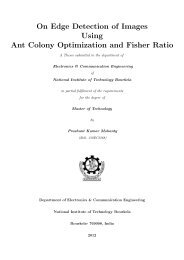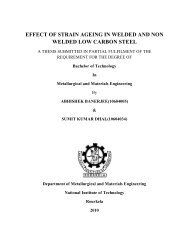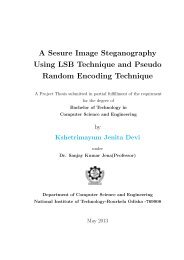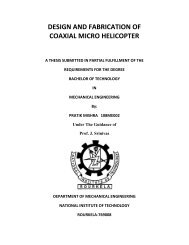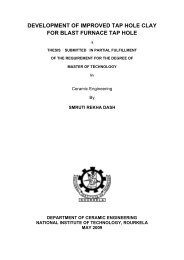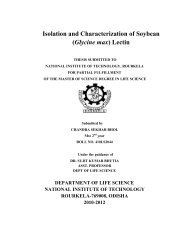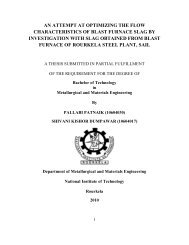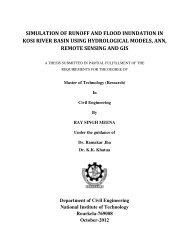analysis of transient heat conduction in different geometries - ethesis ...
analysis of transient heat conduction in different geometries - ethesis ...
analysis of transient heat conduction in different geometries - ethesis ...
Create successful ePaper yourself
Turn your PDF publications into a flip-book with our unique Google optimized e-Paper software.
θ =<br />
− τU<br />
e + V<br />
U<br />
⎛<br />
2B<br />
⎞<br />
U = ⎜ ⎟<br />
⎜1+ B ⎟<br />
Where 4<br />
⎝ ⎠ ( 1+<br />
B )<br />
, 4<br />
35<br />
V =<br />
G<br />
(3.101)<br />
Based on the <strong>analysis</strong> a closed form expression <strong>in</strong>volv<strong>in</strong>g temperature, <strong>in</strong>ternal <strong>heat</strong> generation<br />
parameter, Biot number and time is obta<strong>in</strong>ed for a tube.<br />
3.6 TRAINSIENT HEAT CONDUCTION IN SLAB WITH DIFFERENT<br />
PROFILES<br />
In this previous section we have used polynomial approximation method for the <strong>analysis</strong>. We<br />
have used both slab and cyl<strong>in</strong>drical <strong>geometries</strong>. At both the <strong>geometries</strong> we have considered a<br />
<strong>heat</strong> flux and <strong>heat</strong> generation respectively. Consider<strong>in</strong>g <strong>different</strong> pr<strong>of</strong>iles, the <strong>analysis</strong> has been<br />
extended to both slab and cyl<strong>in</strong>drical <strong>geometries</strong>. Unsteady state one dimensional temperature<br />
distribution <strong>of</strong> a long slab can be expressed by the follow<strong>in</strong>g partial <strong>different</strong>ial equation. Heat<br />
transfer coefficient is assumed to be constant, as illustrated <strong>in</strong> Fig 3.5. The generalized <strong>heat</strong><br />
<strong>conduction</strong> equation can be expressed as<br />
∂T 1 ∂ ⎛ m ∂T<br />
⎞<br />
= α r m ⎜ ⎟<br />
∂t r ∂r⎝ ∂r<br />
⎠ (3.102)<br />
Where, m = 0 for slab, 1 and 2 for cyl<strong>in</strong>der and sphere, respectively.<br />
Boundary conditions are<br />
∂ T<br />
= 0<br />
∂ r at r = 0<br />
(3.103)<br />
∂ T<br />
k =−h( T −T∞)<br />
∂ r<br />
at r = R<br />
(3.104)<br />
And <strong>in</strong>itial condition: T=T0 at t=0 (3.105)<br />
In the derivation <strong>of</strong> Equation (3.102), it is assumed that thermal conductivity is <strong>in</strong>dependent <strong>of</strong>





